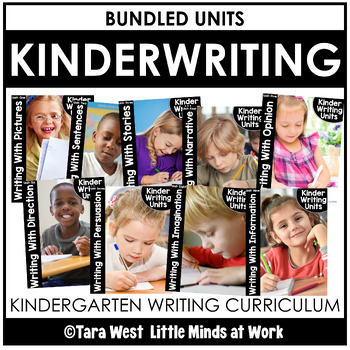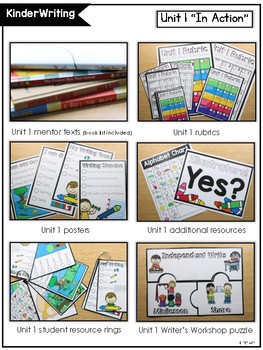KinderWriting® Kindergarten Writing Curriculum BUNDLED
- Zip
What educators are saying
Products in this Bundle (9)
showing 1-5 of 9 products
Description
KinderWriting® Curriculum Units BUNDLED is an engaging, standards-based kindergarten, genre-based writing curriculum. This bundle is designed for the kindergarten classroom and easily adapted to fit a guardian-led homeschool setting! If inquiring about this bundle for a homeschool setting, feel free to email me directly with any questions at tara@littlemindsatwork.org!
Do you have a few extra moments? Watch THIS video!
What is KinderWriting?
KinderWriting® Curriculum is an engaging, kindergarten, genre-based writing curriculum. KinderWriting® encourages young learners to look inward at their endless possibilities as a writer. KinderWriting® is based upon nine units: Writing With Pictures, Writing With Sentences, Writing With Stories, Writing With Narrative, Writing With Opinion, Writing With Direction, Writing With Persuasion, Writing With Imagination, and Writing With Information. Each unit is broken down to 20 lessons. The units cover 20 days of academic instruction. The lesson plans have listed unit objectives, “I can” statements, Common Core writing standards and needed mentor texts.
KinderWriting® encourages a daily routine of a minilesson, independent writing, and a share time. Each of the lessons in KinderWriting® are well thought out for the young writer and spiral back to previous lessons to ensure students are retaining their skills. KinderWriting® also includes unit anchor charts, a variety of writing paper, conferring schedules and note sheets, sample writings, student writing goals display, writing rubrics, and step-by-step guides that are made specifically for each unit.
What is included in KinderWritring Curriculum?
-Teacher "simple read" lesson plans. You will not need to rewrite these lesson plans, unless you choose do. If so I have included editable lesson plans.
-Each unit I have planned out the; big idea, focus standard, essential questions, and so much more!
-Writing paper
-Unit posters
-Student material
-Unit rubrics
-Spanish posters included
What Units are Covered?
Unit 2: Writing with Sentences
Unit 4: Writing with Narrative
Unit 6: Writing with Direction
Unit 7: Writing with Persuasion
Unit 8: Writing with Imagination
Unit 9: Writing with Information
What lessons are included?
Unit 1: Writing With Pictures
Lesson 1: Illustrators! Yes?
Lesson 2: Establishing the Minilesson
Lesson 3: Drawing Sticks, Circles, & Boxes
Lesson 4: Establishing Independent Write
Lesson 5: Share Time
Lesson 6: Illustrating the Best I Can
Lesson 7: Detailed Pictures
Lesson 8: Visualizing My Story
Lesson 9: Looking Closely
Lesson 10: Setting Goals
Lesson 11: What is a Label?
Lesson 12: Adding Labels
Lesson 13: The Pencil
Lesson 14: Labeling for Detail
Lesson 15: Ask and Write
Lesson 16: Show and Retell Stories
Lesson 17: Labeling Your Name
Lesson 18: Sticky Conferences
Lesson 19: A Picture Book
Lesson 20: Celebration
Unit 2: Writing With Sentences
Lesson 1: Authors! Yes?
Lesson 2: Authors Persevere
Lesson 3: Writing Tools- ABC Chart
Lesson 4: Making Words
Lesson 5: Writers Make Mistakes
Lesson 6: Stretching Sounds
Lesson 7: Stretching More Sounds
Lesson 8: Writing Tools- Sight Word Chart
Lesson 9: Color Words
Lesson 10: Letters vs. Words
Lesson 11: Conferring and Writing Partnerships
Lesson 12: Speech Bubbles and Emotion
Lesson 13: Using the Room
Lesson 14: Are You Really Done?
Lesson 15: Capitals
Lesson 16: Spacing
Lesson 17: Punctuation
Lesson 18: Words Make Sentences
Lesson 19: Writing Storybooks
Lesson 20: Sharing Storybooks
Unit 3: Writing With Stories
Lesson 1: Storytellers! Yes?
Lesson 2: Authors Write About What They Love
Lesson 3: Authors Write About What They Can Do
Lesson 4: Authors Write About What They Know
Lesson 5: Authors Write About The Past
Lesson 6: Mechanics Matter
Lesson 7: Names and Places Use Capitals
Lesson 8: Tap Out the Story
Lesson 9: Powerful Punctuation
Lesson 10: Ask More With Writing Partners
Lesson 11: A 5 W’s Story
Lesson 12: Topics are Everywhere
Lesson 13: Books are Stories
Lesson 14: Places are Stories
Lesson 15: Colors are Stories
Lesson 16: Elapsed Time
Lesson 17: Adding On
Lesson 18: Illustrations Tell Stories
Lesson 19: Storytelling Booklets
Lesson 20: Sharing Storybooks
Unit 4: Writing With Narrative
Lesson 1: Narrators! Yes?
Lesson 2: Narratives Use Words Like I, Me and My
Lesson 3: Narratives Have a Setting
Lesson 4: Narratives Have a Problem & Solution
Lesson 5: Narratives Have a BME
Lesson 6: Starting With a Hook
Lesson 7: Ending With Feeling
Lesson 8: Sequential Words
Lesson 9: “Zoom” In Moments
Lesson 10: Using Details
Lesson 11: Writing With the 5 Senses
Lesson 12: Adding in Adjectives
Lesson 13: Adding in Verbs
Lesson 14: Words Have Families
Lesson 15: Mechanics
Lesson 16: Narrative Booklets
Lesson 17: Writing With a Rubric
Lesson 18: Writing Process- Draft
Lesson 19: Writing Process- Polish
Lesson 20: Writing Process- Publish
Unit 5: Writing With Opinion
Lesson 1: Opinionators! Yes?
Lesson 2: Giving Opinions
Lesson 3: Fact vs. Opinion
Lesson 4: Opinions Around Us
Lesson 5: Opinions on the Spot
Lesson 6: Using the Word Because
Lesson 7: Giving Two Reasons
Lesson 8: Using a Mentor Text
Lesson 9: Opinion Starters
Lesson 10: Defending an Opinion
Lesson 11: Using the Word Wall
Lesson 12: Spacing for Our Readers
Lesson 13: Setting Letters on the Line
Lesson 14: Reversals and Handwriting
Lesson 15: Sounds in Words
Lesson 16: Sharing Opinions
Lesson 17: Writing With a Rubric
Lesson 18: Writing Process- Draft
Lesson 19: Writing Process- Polish
Lesson 20: Writing Process- Publish
Unit 6: Writing With Direction
Lesson 1: Teachers! Yes?
Lesson 2: Writing How-To Stories
Lesson 3: Choosing a How-To Story
Lesson 4: Using Pictures in How-To Stories
Lesson 5: Transitional Words
Lesson 6: Hands-On How-To Story
Lesson 7: Hands-On How-To Story
Lesson 8: Labeling Pictures
Lesson 9: Speech Bubbles
Lesson 10: Number the Steps
Lesson 11: Skip a Step
Lesson 12: Rereading to Clarify
Lesson 13: Spacing For Our Readers
Lesson 14: Diagrams
Lesson 15: Sounds
Lesson 16: Writing Across the Pages
Lesson 17: Writing With a Rubric
Lesson 18: Writing Process- Draft
Lesson 19: Writing Process- Polish
Lesson 20: Writing Process- Publish
Unit 7: Writing With Persuasion
Lesson 1: Persuaders! Yes?
Lesson 2: Writing Persuasive Stories
Lesson 3: Cookie Persuasion
Lesson 4: Strong Persuasion
Lesson 5: Persuasive Illustrations
Lesson 6: Persuading Characters
Lesson 7: Persuading Characters
Lesson 8: Persuasive Words
Lesson 9: Mechanics
Lesson 10: Spacing
Lesson 11: Friendly Letters
Lesson 12: Persuasive Friendly Letters
Lesson 13: Mapping a Persuasive Letter
Lesson 14: Drafting a Persuasive Letter
Lesson 15: Publishing a Persuasive Letter
Lesson 16: Persuading With a Cause
Lesson 17: Making an Argument
Lesson 18: Writing Process- Draft
Lesson 19: Writing Process- Polish
Lesson 20: Writing Process- Publish
Unit 8: Writing With Fiction
Lesson 1: Fiction Stories Have Characters
Lesson 2: Fiction Stories Have a Setting
Lesson 3: Fiction Stories Have a BME
Lesson 4: Fiction Stories Have a Problem & Solution
Lesson 5: Fiction Stories Have Speech & Sounds
Lesson 6: Fairy Tales
Lesson 7: Fairy Tales Have Magical Characters
Lesson 8: Fairy Tales Have Magic & Love
Lesson 9: Fairy Tales Have a Royal Setting
Lesson 10: Fairy Tales Have a Special Beginning & Ending
Lesson 11: Fairy Tale Organizer
Lesson 12: Drafting a Fairy Tale
Lesson 13: Drafting a Fairy Tale
Lesson 14: Drafting a Fairy Tale
Lesson 15: Publishing a Fairy Tale
Lesson 16: Poetry Introduction
Lesson 17: I Like Poems
Lesson 18: Acrostic Poems
Lesson 19: Sensory Poems
Lesson 20: Publishing a Poem
Unit 9: Kindergarten Writing With Information
Lesson 1: Researchers! Yes?
Lesson 2: Writing Informational Stories
Lesson 3: What am I? Clue Stories
Lesson 4: Narrowing the Writing Topic
Lesson 5: Elaborating on a Topic
Lesson 6: Nonfiction Text Features - Labels
Lesson 7: NF Text Features - Captions
Lesson 8: NF Text Features - Maps & Diagrams
Lesson 9: NF Text Features - Close-Ups & Photos
Lesson 10: NF Text Features - Table of Contents & Glossary
Lesson 11: Reports Introduction
Lesson 12: Research Organization
Lesson 13: Opening and Closing
Lesson 14: Drafting a Research Paper
Lesson 15: Published Research Report
Lesson 16: Biographies
Lesson 17: Writing a Biography
Lesson 18: Autobiographies Introduction
Lesson 19: Autobiography Draft
Lesson 20: Autobiography Final Draft
What about the standards?
Each unit has a focus standard that is based upon the Common Core Standards. Units further into the year will have more than one focus standard. If you teach to a varying set of standards, you can email me for assistance. Thanks!
Ah, I love this but I teach PreK/First/Sped
You will notice that this packet is marked as Pre-K, Kindergarten and First Grade! This is not something I do often or lightly! I find it very frustrating to purchase a packet and it not be grade level appropriate. When it comes to writing there are two major parts to a writing block. The mini lesson and the independent writing time. In a mini lesson, we are able to meet students at their level and expand through modeling of our own stories. If working with Pre-K students, you might need to expand on your teacher modeling and spend less time on the independent writing. For first grade, you will want to lessen the modeling and increase student independent writing time. At this time I do not have a separate Pre-K writing program planned. I do have plans to release a first grade writing program in the summer of 2018. Please note that NO student materials have the "KINDER" name on them so you do not have to worry about this! As teachers we are the only ones to ultimately make the decision as to know if it will work for our kids, if I can help with this decision please let me know!
Questions?
Please email me at littlemindsatworkllc@gmail.com
Would you like to receive notifications for my newly released packets and upcoming sale? Be sure to FOLLOW ME here on TPT!
**Join my private Facebook Group to join fellow Pre-K, Kindergarten, First Grade and Second Grade teachers that use my curriculum! Collaborate, chat and share ideas with like-minded teachers! Join the private Facebook group H E R E!
Visit my blog Little Minds at Work
Follow me on Facebook
RAKB2B





